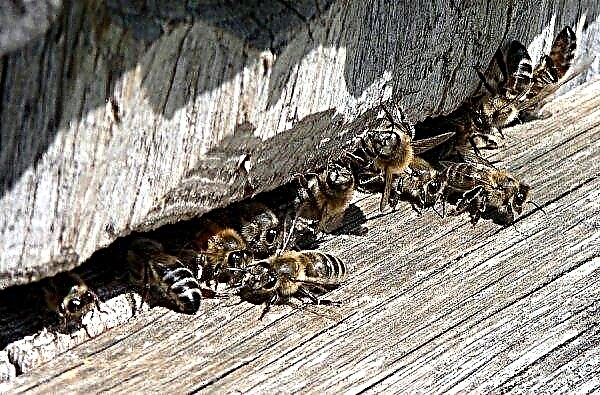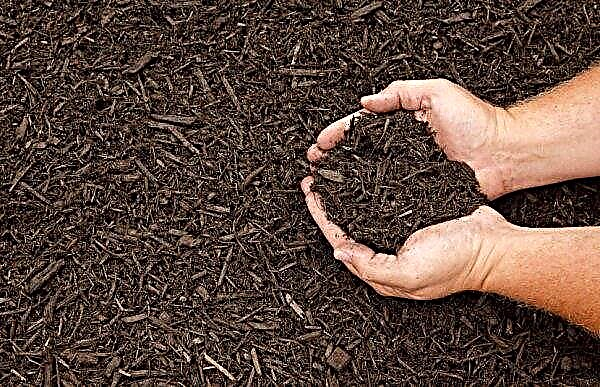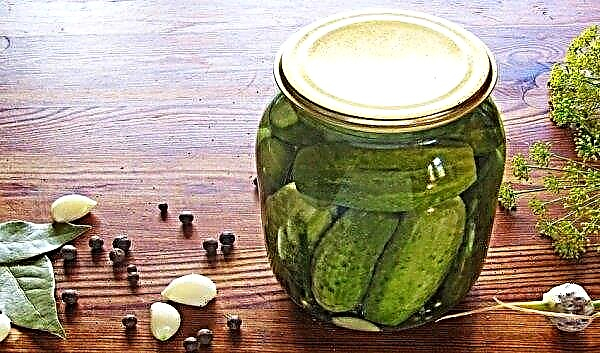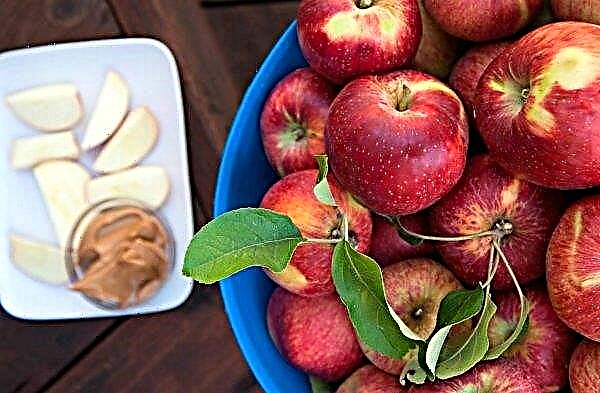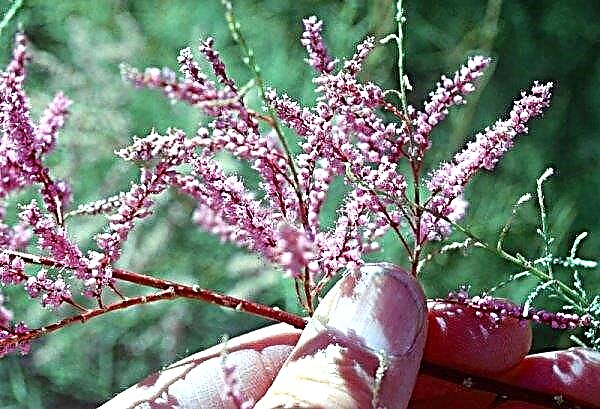Panicled hydrangea is a popular garden shrub, most varieties of which are quite unpretentious, resistant to frost, disease and pests, and at the same time look great on personal plots. Thanks to such qualities, the plant has gained considerable popularity among gardeners, but far from all of them know about whether to prune the plant.
Is hydrangea trimmed
Hydrangea (the scientific name of the plant) can do without pruning, however, the shrub grows better with regular procedures. In principle, we can say that the vast majority of plants this operation is either absolutely necessary, or they tolerate it quite normally, that is, it will not interfere.
Did you know? The hydrangea contains cyanophores glycosides - substances whose ingestion can cause poisoning. Thus, this is a poisonous plant, although, to harm the body, you need to eat a lot of it.
Trimming hydrangea is recommended for the following reasons:
- Crown formation. This type of plant has, for the most part, a decorative purpose, and, therefore, should look beautiful. Some plants, for example, certain varieties of fir, do not cut, because the natural appearance is what they are planted for. Hydrangea does not belong to such plants - it is large and sprawling, this also has a charm, but most gardeners believe that when used in landscape design, the formed crown looks better.
- Bloom. The plant forms inflorescences only on young shoots, like lilacs, that is, the more thoroughly the old shoots are removed, the more abundant the shrub will bloom next season. Indeed, instead of one cut old branch, several young ones will appear that will give magnificent inflorescences.
- Prevention of diseases, pests and rejuvenation. Sanitary pruning helps to get rid of old, sick, dry, frost-bitten branches and make the bush younger. In addition, excessive thickening contributes to the appearance of parasites and diseases, which, of course, is prevented by the timely removal of excess growth.

Rules for trimming panicle hydrangea
Although different types of pruning differ in their goals and execution mechanism, there are several general rules that are specific to any type of procedure:
- During the operation, use only a well-honed and sanitized pruning shears to avoid injury to the shrub.
- After completing the procedure, be sure to treat the slices with garden var.
- The branches, even dry ones, under no circumstances can be broken off, only cut.
- To remove inflorescences of the last season, frozen, dry and diseased shoots should be in good clear weather, but before the sap flow begins. You can do this in March or October when hydrangea is sleeping.
- Cut the shoot should be no closer than 2-3 cm from the nearest kidney.
- Do not leave unprocessed sections and hemp, it is imperative to use garden varieties or fungicides after surgery.
- To remove branches of large diameter, you need to use a saw and leave even cuts (so that there are no edges with removed sections of the bark or protruding chips), and then process them with var.
- Cut the branches with secateurs in the diagonal plane, so that in the section an oval is formed, not a circle.
- On large bushes, pruning should be carried out gradually, over 2-3 seasons. If you do the capital procedure immediately, the probability of plant death is high.
Hydrangea pruning dates
It is believed that hydrangea is more favorable for spring pruning, which should be done as early as possible before the active sap flow begins. A more accurate time depends on the specific region, but it is quite simple to calculate it: as soon as the kidneys start to wake up, it's time to take on the pruning shears. Most often, the operation is carried out from the first decade of March until the beginning of April. In addition, climatic conditions must be taken into account.
The procedure should not be done if the kidneys began to swell, and at that time night frosts returned. You should wait until a fairly high air temperature is established, and then perform the operation. The fact is that pruning is stress for the plant, hydrangea after it is weakened, you should not expose it to an additional unfavorable factor. However, delaying the operation is also not necessary. In the spring, the plant departs from sleep very quickly, and if you perform an operation on an awakened bush, flowering this season is most likely not to be expected. Usually the maximum late spring procedure is the last decade of April, not later. Perform the event in the fall. Most often, this is a sanitary procedure, the purpose of which is the removal of dry, old and diseased shoots, that is, those branches are cut that will no longer give inflorescences, and with their mass only burden the bush. The formative type of operation in the autumn period can be done if for some reason it is necessary, but it is better to refrain from it. As you know, pruning stimulates growth, and there is a danger that improperly selected dates for the event will adversely affect young shoots, and they will freeze. It should be borne in mind that this type of procedure does not require immediate execution, usually it can be safely postponed until the next season.
Most often, this is a sanitary procedure, the purpose of which is the removal of dry, old and diseased shoots, that is, those branches are cut that will no longer give inflorescences, and with their mass only burden the bush. The formative type of operation in the autumn period can be done if for some reason it is necessary, but it is better to refrain from it. As you know, pruning stimulates growth, and there is a danger that improperly selected dates for the event will adversely affect young shoots, and they will freeze. It should be borne in mind that this type of procedure does not require immediate execution, usually it can be safely postponed until the next season.
Did you know? Hydrangea came to Europe from Japan in 1820, where at the beginning of the 20th century, breeders began to work with the plant. The first European varieties were developed by the French Nancy, Muer, Lemoine, Wendom, and by the middle of the century there were already about a hundred varieties of plants, originally from the Old World.
Spring
First of all, a few words should be said about the benefits of spring pruning:
- after the operation, the processes of restoration are started in the plant, immunity is strengthened, vital activity and sap flow are activated;
- promotes rejuvenation of the bush;
- forms a crown, contributes to its splendor and healthy density;
- beneficial effect on the size and number of inflorescences.
The operation is performed not to reduce the size and volume of the plant, but to achieve the above goals. If the shrub has been planted correctly, there should be enough space for it, even if it is not pruned. After all, it is known that when planting hydrangea, it is necessary to maintain a distance between it and other vegetation or a building of at least 2.5 m. The timing of the spring procedure was mentioned above (March-early April), as for the main purpose of spring pruning, this is the removal of frozen, damaged by snow and wind, dry branches.
Frozen shoots are removed to healthy tissues. Although this species is quite frost-resistant, cases of shoot damage, especially young ones, occur in winter frosts. Sometimes this can happen as a result of late application of nitrogen fertilizers or incorrectly selected period of autumn pruning. In addition, this circumstance may occur in regions with severe snowless winters or in atypically severe frosts. After the sanitary procedure, the regulatory is performed. About how the operation is performed will be described in more detail below. Finally, a formative operation is performed. The basic rule (in more detail about this type of event will be described below) of the procedure is the removal of small shoots, as well as branches directed inside the plant. At the same time, on strong healthy branches, 2-3 of the strongest shoots with the largest number of buds are selected and left, the rest of the shoots are removed.
After the sanitary procedure, the regulatory is performed. About how the operation is performed will be described in more detail below. Finally, a formative operation is performed. The basic rule (in more detail about this type of event will be described below) of the procedure is the removal of small shoots, as well as branches directed inside the plant. At the same time, on strong healthy branches, 2-3 of the strongest shoots with the largest number of buds are selected and left, the rest of the shoots are removed.
Video: pruning panicle hydrangea for flowering in spring
Fall
In the autumn, as already mentioned above, sanitary pruning is carried out mainly, regardless of whether you will make winter shelter for hydrangea or not. Skeletal branches during such an event do not touch, but they cut off the lateral, side, thin and those that grow inward.
In the case when hydrangea is grown in a tub or indoors, you can trim it before winter itself, then the plant will bloom lushly and plentifully next year. The plant has large and lush inflorescences, which in some varieties can reach a length of more than 35 cm. Such massive brushes, combined with the weight of the snow mass, are able to break off the branches of the bush, so these clusters should be cut before wintering.
Important! It is advisable to take into account the location of those shoots that you leave when performing forming pruning, so that the direction of growth of the branches is harmoniously combined. For example, on a strong, horizontally located branch, you can leave 3 shoots with a large number of buds, one of which grows up, the other two - slightly down and in different directions.
Some gardeners believe that if hydrangea is grown in the northern latitudes or in regions with fairly severe winters, it should not be pruned heavily. They argue their position by the fact that such a procedure has a bad effect on the winter hardiness of the plant. This point of view has a rather serious justification: in severe winters, pruning under the root can cause excessive freezing of young shoots and even fairly thick branches. In addition, pathogenic bacteria can get into cracks and cavities that do not have time to tighten after surgery, causing serious diseases and even death of the shrub. After performing a gentle procedure in the northern latitudes, it is advisable to cover the plants in the winter. To do this, make a dry shelter: they wrap a bush with non-woven fiber like a spunbond, and the trunk circle is mulched with a layer of 10–12 cm. Then, within a radius of 30–35 cm from the center of the trunk circle, a mesh frame with a height of shrubs is installed. Dry foliage is poured into the formed interior space, and a film protecting from moisture and snow is thrown on top. Tie loads to the corners of the film or fix it with a tourniquet so that the wind does not blow off.
After performing a gentle procedure in the northern latitudes, it is advisable to cover the plants in the winter. To do this, make a dry shelter: they wrap a bush with non-woven fiber like a spunbond, and the trunk circle is mulched with a layer of 10–12 cm. Then, within a radius of 30–35 cm from the center of the trunk circle, a mesh frame with a height of shrubs is installed. Dry foliage is poured into the formed interior space, and a film protecting from moisture and snow is thrown on top. Tie loads to the corners of the film or fix it with a tourniquet so that the wind does not blow off.
Types: pruning panicle hydrangea in the fall
Trimming Types
There are several types of trimming, each of which has its own characteristics and is performed for a different purpose. Although, for example, in the spring, various varieties of the procedure can be carried out alternately, complementing one another.
Did you know? Hydrangea can have flowers of various shades of blue and lilac. This is explained by the ability to assimilate aluminum, which is rich in acidic soils, so loved by this plant.
Anti-aging
It is made to make the bush younger and healthier. Such pruning is not done for a young plant; it makes no sense to rejuvenate hydrangea before 6–7 years of life.
The algorithm of actions is as follows:
- Remove all old branches that interfere with the growth of young shoots.
- The entire growth of 3-4 years old is cut to the ground.
- After the operation, 8–10 of the strongest and most powerful shoots should remain on the bush.

Formative
This procedure is performed in the first years of the plant's life. It is very important to carry out the operation correctly during the first three seasons after planting a bush. Particular attention is paid to skeletal branches - the base of the bush.
In the planting season, they do not need to be formed, but in the future this is done according to the following scheme:
- In early spring, all last year's shoots are cut almost to the ground. Such an operation is performed to create a solid support for the plant, and he will need it very much in the future.
- The next year, at the same time (the third season after planting), the branches need to be cut again, but already leaving longer residues, each of which should have 1-3 buds.
- The shoots growing inside must be cut off regardless of whether there are buds on them, since this shoot makes the crown excessively dense, prevents the penetration of sunlight into the inside and worsens aeration, creating favorable conditions for the development of diseases.

Tree view
Depending on the concept of your garden and the general idea of decorative design, you can form panicled hydrangea traditionally, like a shrub, or in the form of a tree (standard form). For growing the stem, at first you should remove all zero shoots, leaving one, the strongest. This tree-like shoot should be tied up and regularly corrected to achieve vertical growth.
In summer, all annual shoots should be removed from the main shoot (stem), so that all life resources of the hydrangea are directed to the development of the trunk. For the next season, in spring, hemp need to be cut into a ring, then the crown is also formed. Do this from last year's shoots, cutting off their upper parts when the tree reaches 60-100 cm in height. Hydrangea, formed in the form of a tree, is quite rare. To obtain a more or less tree-like plant, you need at least 3-4 years, and this is a rather long period.
In the form of a bush
In the event that you want your hydrangea to develop in the form of a bush, when planting, slightly deepen the root neck in the ground. Then several shoots will start to grow from the ground at once, they are called zero. Give them a little stronger, then leave the strongest and most powerful, cut off the rest under the root. Next, it is necessary to form a crown, removing branches that prevent the entire shrub from growing. In addition, it is necessary to cut the shoots of the last season by a third, leaving 1-3 buds.
Sanitary
Hydrangea is healed in the fall, before preparing the plant for winter. The scheme is as follows:
- All old, diseased and damaged branches are deleted.
- Weak shoots that may grow stronger in the future are cut off, leaving a stump 6–8 cm high.
- In the event that the plant is diseased, or has been attacked by pests, radical pruning is performed - all the shoots are removed, leaving only the remains of skeletal branches 50-60 cm long in the ground. Next season, after such a “surgical operation”, there is no flowering , naturally, there can be no question, but you will save the plant. Under favorable circumstances, it will eventually depart, perhaps even in a year.

Regulatory
This type of procedure is otherwise called stimulating. The name speaks for itself, its purpose is to create favorable conditions for plentiful long flowering.
The operation is very simple, perform it as follows:
- The annual shoots are cut by about a third, although more can be, the main thing is that they have 2-3 buds left, which will give life to young shoots with a new color.
- Dry and diseased shoots are removed.
- Old shoots growing from the ground itself are cut to the ground.
Care after trimming
After pruning any type of shrub, care should be taken. This must be done for a speedy recovery and restoration of hydrangea. First of all, abundant and regular watering should be provided, and after it - loosening the soil, in order to avoid the formation of a crust on the soil surface. For the speedy restoration of hydrangea, the soil around it, and especially the trunk circle, the first time after the operation should be slightly moistened constantly. The next step is fertilizer application. Timely dressing contributes to a quick and painless recovery.
Important! Before the autumn procedure, as well as after it, hydrangea should not be fertilized with nitrogen. This mineral stimulates the growth of shoots, and young shoots can freeze in winter.
In spring, you should add cow dung or bird droppings. For this, 1 kg of excrement is bred in 1 bucket of water and insisted for 2 weeks. One liter of the obtained infusion (a characteristic smell will tell you about its readiness) is dissolved in 10 liters of water and watered around the trunk. You can use potassium or calcium nitrate (2 tbsp. L. Per 1 bush).In the fall, nitroammophoska is used (sprinkle 2 tbsp. In the near-stem circle), wood ash (dissolve 0.5 l in 1 bucket of water / 1 plant). If the plant is quite young, or in your region there are often severe frosts and snowless winters, you should take care of the winter warming of the trunk circle, and maybe the creation of a shelter. More often than not, correct mulching is enough. Make a layer 10-12 cm thick of pine sawdust, needles and peat, taken in approximately equal parts. Summing up, it should be said that trimming panicle hydrangea is not a mandatory, vital procedure, but it is better to perform it. She, for many reasons, which was mentioned above, contributes to the growth, beautiful appearance and strong immunity of the plant.
If the plant is quite young, or in your region there are often severe frosts and snowless winters, you should take care of the winter warming of the trunk circle, and maybe the creation of a shelter. More often than not, correct mulching is enough. Make a layer 10-12 cm thick of pine sawdust, needles and peat, taken in approximately equal parts. Summing up, it should be said that trimming panicle hydrangea is not a mandatory, vital procedure, but it is better to perform it. She, for many reasons, which was mentioned above, contributes to the growth, beautiful appearance and strong immunity of the plant.

